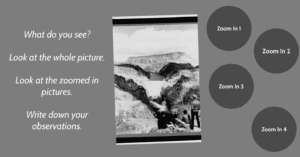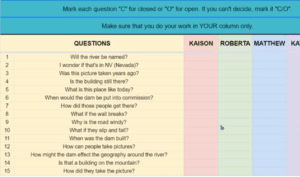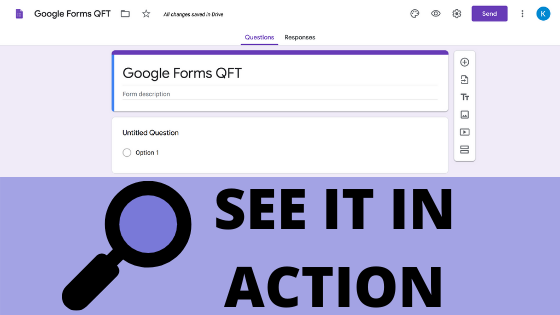You can still conduct a rich and fun inquiry from home – start by getting a long list of students’ questions. Alyssa Park, a 4th grade teacher from Gardnerville, NV, used google forms to help students lead themselves through a step-by-step inquiry about the Hoover Dam. She started with a primary source from the Library of Congress that would spark their curiosity. In the Google Form, on day one, she linked them to a Prezi so they could closely observe the image by zooming in and out on different parts and then opened it up to their questions. What were they curious about, what did they already know, and what more did they want to discover about the Hoover Dam? 
Student asked questions individually at home and entered them into a Google Forms Park had created. Some students even got siblings or parents to contribute questions too. Students asked everything from “How many gallons of water does the dam let out?” to “Who took the picture of the men taking the picture?” to “Will the dam still be there in a hundred years?” Park tweeted: “In total, my 4th graders asked 282 questions!”
 Park copied all questions into a Google Sheet (Google Forms has this function) that students could work out of. Over the next few days, students got into virtual groups and sorted, improved, and prioritized their questions, landing on three they’d like to tackle first. She used Screencastify to give students instructions along the way. Park wrote on Twitter: “Long-distance #qft work means chunking the process to allow all Ss to participate. Thankfully, the design of the QFT allows for this. I divided the class’s Qs among 5 groups & sent video directions w/ @Screencastify on how to classify Qs on a Google Sheet.” With each student equipped with three of their own questions, they researched using a collection of digital books and “presented” their findings to their classmates using Google Slides.
Park copied all questions into a Google Sheet (Google Forms has this function) that students could work out of. Over the next few days, students got into virtual groups and sorted, improved, and prioritized their questions, landing on three they’d like to tackle first. She used Screencastify to give students instructions along the way. Park wrote on Twitter: “Long-distance #qft work means chunking the process to allow all Ss to participate. Thankfully, the design of the QFT allows for this. I divided the class’s Qs among 5 groups & sent video directions w/ @Screencastify on how to classify Qs on a Google Sheet.” With each student equipped with three of their own questions, they researched using a collection of digital books and “presented” their findings to their classmates using Google Slides.
With the background research done, they could now move on to some of their deeper questions, ones that got into attitudes of the people involved in and affected by the construction of the Hoover Dam. Next, they chose between writing a historical fiction story and an informational article from the perspective of someone whose life was affected by the dam. Knowing these objectives, students chose 3 new priority questions accordingly and did another round of research using a resource bank created by Park. The results were tremendous. After students had worked through the writing process, Park chose two final drafts of student writing to share. She said, “All the work of the #QFT and the next steps- finding the right QFocus, students questioning and pursuing the most help

In a follow up interview, she shared, “I was really impressed with the work they did. I have had some conversations with colleagues in the past about how elementary students can’t ask really good questions and how they can’t do good research or they’re just not old enough or ready enough for it yet because they’re only in elementary school. I think that the work that my kids did really proves that sentiment wrong, that kids of any age are good question askers, if you give them the opportunity.”
Learn more about Alyssa’s work!
She captured student work and her own reflections on the process everyday of doing this remote QFT on Twitter. Read the whole thread here.
Hear from Alyssa Park as she talks us through her planning process and shows some of the tools she used to make a Google Forms and Google Sheets for 4th graders! Watch Alyssa’s screencast here.
You can recreate what Alyssa did. She created a comprehensive guide to how she conducted a remote QFT using tools from Google Suite and a folder of templates for each of the steps. Get the guide and templates here.
